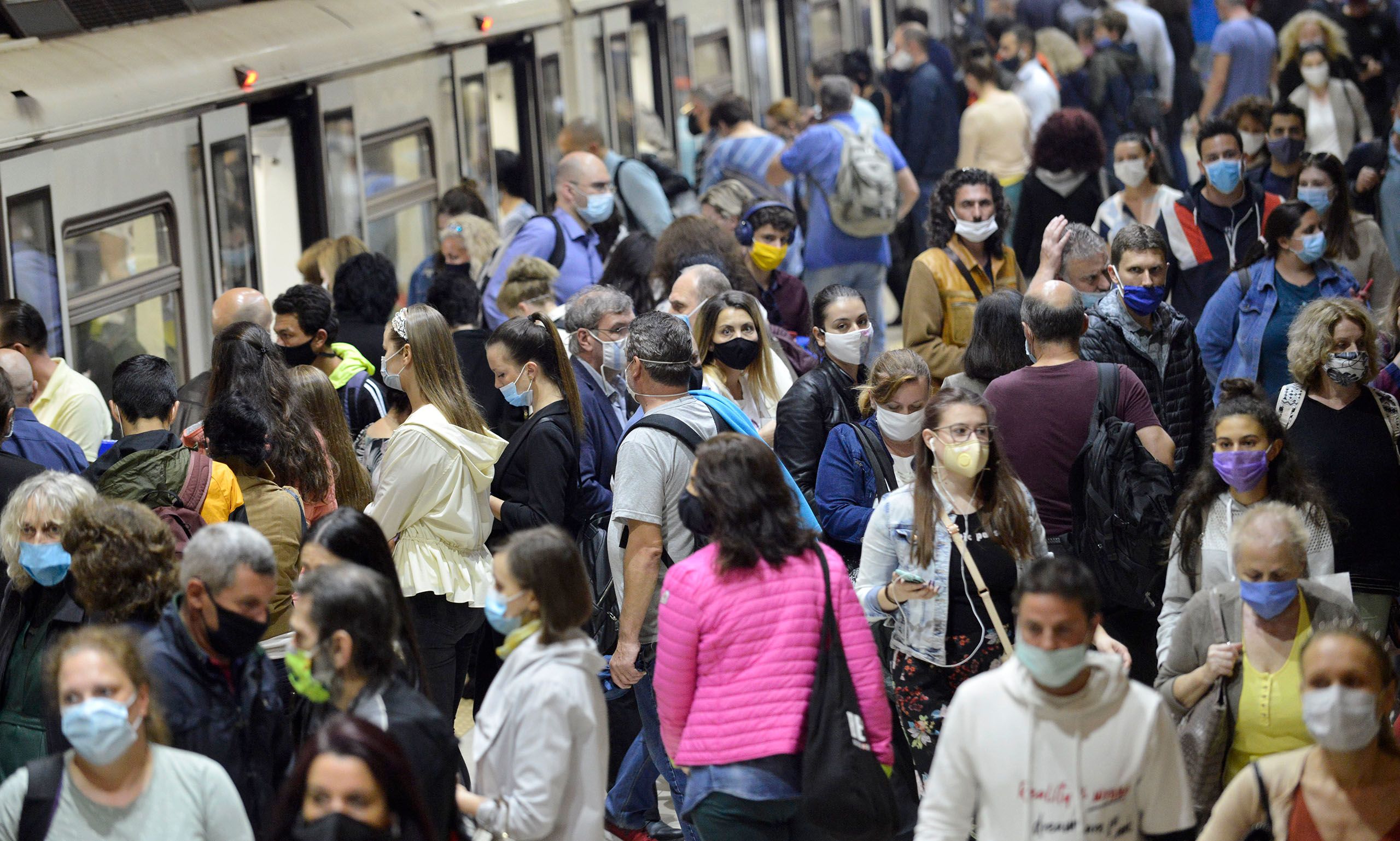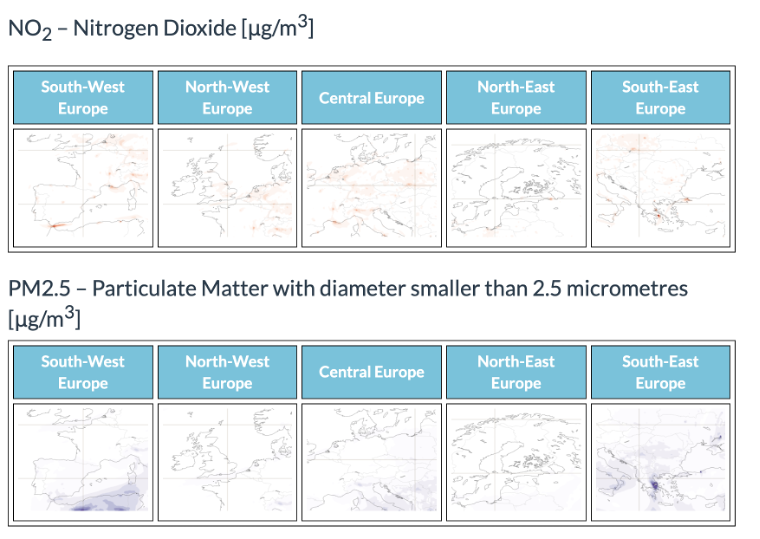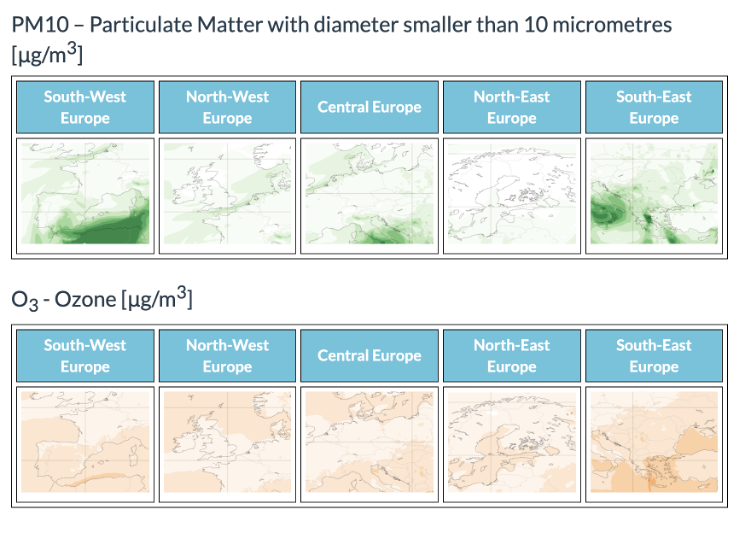Atmospheric monitoring
to support
COVID-19-related research
Using CAMS data to help understand the
coronavirus pandemic

When the novel coronavirus ‘severe acute respiratory syndrome coronavirus 2’ or SARS-CoV-2 first emerged in China at the end of 2019, scientists raced to understand the new virus, how it is transmitted, and what factors impact the severity of the disease.
The Copernicus Atmosphere Monitoring Service (CAMS) offers reliable, near real-time atmospheric data to support the work of researchers and governments around the world. CAMS’ daily air quality monitoring has been essential for those studying the virus, to understand how atmospheric pollutants may contribute to the spread of this airborne pathogen and how they impact on disease severity. As the pandemic evolved, CAMS established a dedicated webpage to COVID-19, with continually updated information on European air quality in the context of the disease.
Meanwhile, as the pandemic drove countries around the world to enact restrictions and lockdowns, traffic volumes decreased and aircraft remained on the ground. Although the impacts for many industries and individuals have been overwhelming, the pandemic presented an unprecedented opportunity to study the effects of drastic reductions in human activity on urban and global air pollution. This information can be used by researchers and authorities to design future urban policies, to help bring about a cleaner world.

Finding the link between COVID-19
and air quality
CAMS’ monitoring and an evolving pandemic
As the pandemic developed during 2020, many countries enacted extensive and prolonged restrictions and lockdowns to curb the spread of the virus. Cities fell silent as citizens were told to stay at home.


Aircraft were grounded, public transport was drastically reduced, and traffic largely disappeared from the streets.
This abrupt and drastic shift in human behaviour presented an opportunity to study the effects on air quality. Human activities like driving and flying contribute to levels of harmful pollutants in the air, such as particulate matter and nitrogen dioxide. The expectation from many was that the reduction in human and industrial activity would lower levels of air pollution, particularly in heavily populated urban areas.
CAMS monitored Europe’s air quality levels to investigate the changes as the pandemic evolved.
COVID-19 affect the lungs and other parts of the human respiratory system. Poor air quality also has detrimental effects on respiratory health, which could potentially worsen the impacts of the virus.
Monitoring air quality, particularly in built-up, heavily-populated urban areas, has become increasingly important since the arrival of the new coronavirus.

The majority of COVID-19 transmission seems to be through contact with an infected person, as they breathe out particles that spread through the air.

Scientists in the epidemiological community are still debating the length of time the viral particles remain infectious as they bind to aerosols suspended in the air.
CAMS data have contributed to research into the underlying transmission. CAMS tracks the distribution and evolution of fine particulate matter in the atmosphere. Scientists can use this to investigate the links between aerosols and viral particles.

It is already becoming clear that air pollution may exacerbate both the spread and severity of COVID-19 symptoms, and that lockdowns helped bring down levels of pollution in the air.

Research into the impacts of air pollution on the spread and severity of COVID-19 is ongoing.
Particulate matter, in the form of dust and black carbon, for example, is known to convey some viruses and increase their spread. COVID-19 is transmitted through the air and scientists in Bergamo, Italy found SARS-CoV-2 in samples of particulate matter. However, it is currently unknown whether this is a significant contributor to the spread of the virus.
If inhaled, particulate matter can also cause inflammation of the airways and potentially exacerbate any symptoms from infection. Research has shown air pollution does increase the mortality rate in patients with COVID-19.
The lockdowns and restrictions brought in by governments around the world have had positive impacts on the environment, however.

Researchers analysed mobility levels in 125 nations and found they decreased by 10% in all but one during April 2020. In five countries, mobility fell by 80% as nationwide lockdowns came into force and people stayed at home.
CAMS assessed the changes in emissions of carbon dioxide and nitrogen oxide during the first wave of the pandemic in 2020. The research used artificial intelligence to analyse emission data and confirmed significant falls in fossil fuel emissions. The largest emission declines in Europe came from Italy, France, Spain, the UK and Germany, with the greatest reductions coming from urban areas.
Observing pollutant data
Air pollution has detrimental effects on human respiratory health. The heart, lung and immune systems are all affected by long term exposure to certain harmful pollutants.
Some atmospheric pollution comes from natural sources such as dust storms, wildfires, volcanoes and vegetation.
Yet industry and transport emissions also release pollutants into the atmosphere.

Lockdown effects
Monitoring pollutant levels can reveal the changes resulting from prescribed restrictions and lockdowns. These calculations must take many variables into account, such as weather conditions.
Pollutant levels are constantly fluctuating, making it challenging to establish a direct causal link. For example, while traffic may decrease during lockdowns, energy use could well increase, as more people remain at home for longer periods of the day.
CAMS expected the most noticeable changes in the levels of nitrogen dioxide, as, close to the surface, this only survives in the atmosphere for one day. Any changes from a particular sector would therefore have a rapid, dramatic and noticeable influence.

CAMS supports the fight against the coronavirus pandemic
Monitoring services dedicated to tracking air pollution

In March 2020, as the pandemic took hold in Europe, CAMS realised its air quality monitoring services could be of great assistance to researchers around the world.
The team at CAMS started focusing on producing easily-understandable information about air pollution over Europe. This included monitoring pollutants such as nitrogen dioxide, ozone and particulate matter.
This information was critical for understanding how meteorological and air quality factors influence the spread of COVID-19.

CAMS particulate matter forecast world map. Credit: Copernicus Atmosphere Monitoring Service, ECMWF.
CAMS particulate matter forecast world map. Credit: Copernicus Atmosphere Monitoring Service, ECMWF.

Examples of proposed mechanisms through which meteorological and air quality (MAQ) factors influence respiratory viral infections. Credit: WMO.
Examples of proposed mechanisms through which meteorological and air quality (MAQ) factors influence respiratory viral infections. Credit: WMO.

Sentinel-5P is a Copernicus mission dedicated to monitoring our atmosphere and plays an essential role in providing data for forecasting and monitoring air quality around the world. Credit: ESA.
Sentinel-5P is a Copernicus mission dedicated to monitoring our atmosphere and plays an essential role in providing data for forecasting and monitoring air quality around the world. Credit: ESA.
Drawing on a network of satellites and ground-based sensors around the world, CAMS could provide daily updates on air quality as human activity changed.
The CAMS team worked to establish the ‘business as usual’ pollution levels, showing what the air quality would have been like had strict lockdowns not been imposed. This allowed researchers to make comparisons between the two situations.
For example, scientists at the Deutscher Wetterdienst, Germany’s meteorological service, used CAMS data to show a stark contrast in ozone levels in the troposphere. These reduced by around 7%; an effect thought to be from lower emissions of pollutants from land, sea and air transport.
CAMS tracks pollutants across Europe
As European countries loosened restrictions following declining coronavirus infection numbers, the team at CAMS looked for evidence of an increase in pollutant levels as societies resumed activities.
An uptick was clearly seen in China, as industries returned to pre-pandemic production levels and people started to travel again. The data showed that nitrogen dioxide concentrations in Beijing for example, returned to pre-pandemic levels already in February 2021.

Difference between the user scenario Covid lockdown and the reference NO2 daily max concentration map. Credit: Copernicus Atmosphere Monitoring Service, ECMWF.
Difference between the user scenario Covid lockdown and the reference NO2 daily max concentration map. Credit: Copernicus Atmosphere Monitoring Service, ECMWF.
CAMS contributes to major World Meteorological Organization report

In March 2021, CAMS offered its extensive air quality monitoring data to the World Meteorological Organization COVID-19 Research Board Task Team. The report analysed the effects of meteorological variables and air quality on the pandemic. CAMS Director Vincent-Henri Peuch was one of 16 experts on the Task Team.
The report found that government policies such as mask-wearing and travel restrictions were the main driver of transmission changes, rather than meteorological and air quality factors.
In another study jointly performed between CAMS and the London School of Hygiene & Tropical Medicine, the researchers found that the impact of various lockdown measures had a different impact on air quality in European cities. For example, school and workplace closures had a much larger impact on reducing pollutant levels than limiting domestic and international travel. Not only the impact on air quality was quantified, the impact on reducing deaths was also evaluated. Scientists estimated that a total of 800 deaths was avoided with the lockdown measures compared to business-as-usual.
Research into these complex connections is continuing, with CAMS producing data and insights that can be used by researchers and policymakers across Europe.
“The CAMS information on atmospheric pollutants effectively complements official EEA monitoring data to provide a robust picture of the impact of lockdowns on air quality across Europe. The cooperation delivered valuable insights of relevance for air quality policies, presented in this 10th edition of the EEA’s Air Quality in Europe report.”
Martin Adams, Head of Programme on Health and Sustainable Resource Use, EEA

The ‘CAMS COVID Resource’
Dedicated air quality monitoring service

Following a surge in interest from researchers, policymakers and the media, CAMS created a new dedicated online resource for atmospheric data related to the pandemic. The new resource was designed to present data in a user-friendly way, to be more accessible to non-specialists, including policymakers and the general public.
The new webpage offers easy access to graphs, maps and animations relating to European air quality in the context of the COVID-19 pandemic. Aside from the daily monitoring of global atmospheric conditions, the new page provides updated contextual air quality information on a daily and weekly basis.
The webpage presents regional maps of key pollutants: ozone; nitrogen dioxide, PM2.5 and PM10. These maps are based on the latest CAMS regional analyses and are updated daily.


The site also shows time series that reveal how background air pollution has evolved throughout the pandemic. This detailed air quality information is available for 50 European cities and reveals levels of the key air pollutants nitrogen dioxide, ozone, PM2.5 and PM10. These charts represent the background urban air pollution in each city and are updated daily.
CAMS realised that to properly assess the situation users would need to distinguish between the impacts of restrictions and lockdowns, and other factors, such as weather, on air quality. The team designed an ‘emissions scenario’ tool, which visualises how air pollution might change with and without lockdowns. This tool is based on CAMS regional air quality analyses.
Finally, the site houses an animated tool showing hourly variations of PM10 and nitrogen dioxide. This application shows clearly the inherent variability in pollutants, to help users understand how atmospheric composition fluctuates under ‘business as usual’ conditions. These are updated on a weekly basis.
Reducing the impacts of
air pollution
Through its dedicated webpage and ongoing monitoring of air pollution in Europe’s cities and around the world, CAMS is contributing to the United Nations’ Sustainable Development Goals (SDGs).



SDG 3 aims to improve the health and well-being of all citizens. Target 3.4 is seeking to reduce early deaths from non-communicable diseases — including respiratory diseases — by a third by 2030.
To achieve this goal, constant monitoring and increasing education about air quality and pollution are necessary. CAMS is helping researchers understand the underlying connections between air pollution and the novel coronavirus. This could benefit not just patients with COVID-19, but could lead to new research avenues helping those with all kinds of respiratory ailments.
Air pollution increases the risk of a range of health problems, including cardiovascular disease, stroke, lung cancer and respiratory infections. CAMS’ extensive data monitoring is helping to visualise and counter its impacts.
The UN SDG 11 is seeking to make cities and communities more sustainable, which includes improving air quality and lowering pollution. The lockdowns led to some reductions in air pollution, though these will likely be short lived as countries come out of the pandemic and strive to return to economic growth and activities at pre-pandemic levels.
Nevertheless, the lessons learned from this global catastrophe could help with the transition towards healthier, greener, safer and more sustainable cities. With CAMS’ daily monitoring of atmospheric changes through the entire pandemic, the research community and policymakers now have a strong foundation of data to form new sustainable policies.
Keeping track of air pollution as the pandemic continues
The COVID-19 pandemic is still ongoing. Significant progress has been made to counter the virus and the disease it causes, but this has mostly been in wealthier, more developed countries.
As the world continues to grapple with the evolving situation, and scientists learn more about how air pollution and the coronavirus are linked, new policies could help to reduce the harmful impact of COVID-19 — and other respiratory diseases.
Scientists continue to unravel the relationship between exposure to air pollution and disease outcome, examining how each country’s response inhibited the spread of the virus, and what role particulate matter plays in spreading airborne pathogens. CAMS will continue to provide detailed atmospheric information to help those researching these fundamental and pressing questions.





